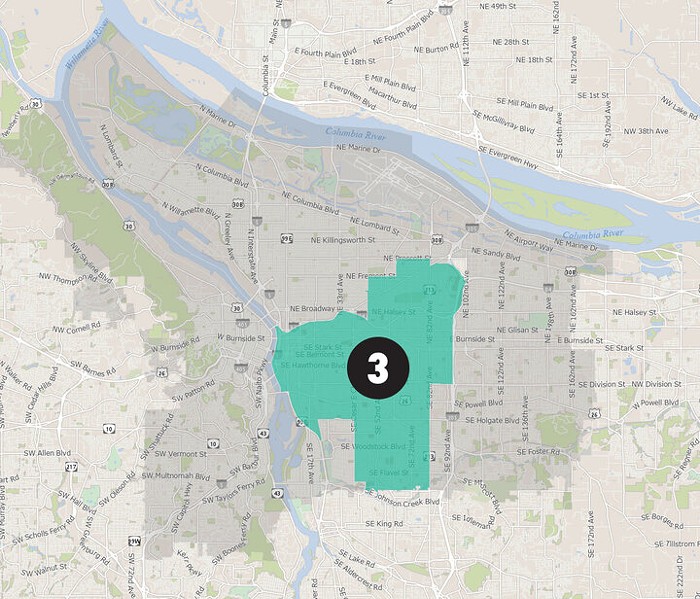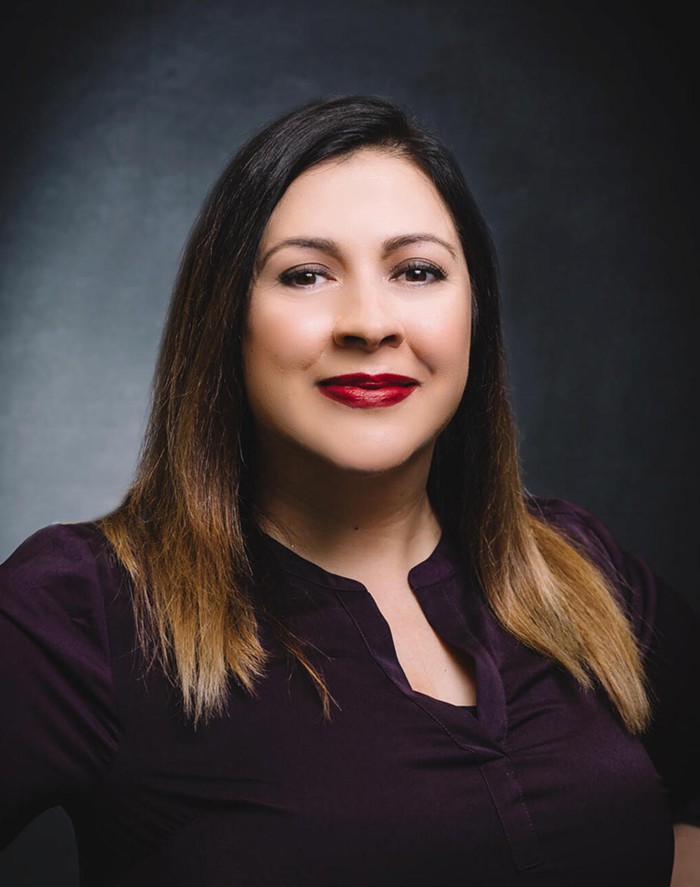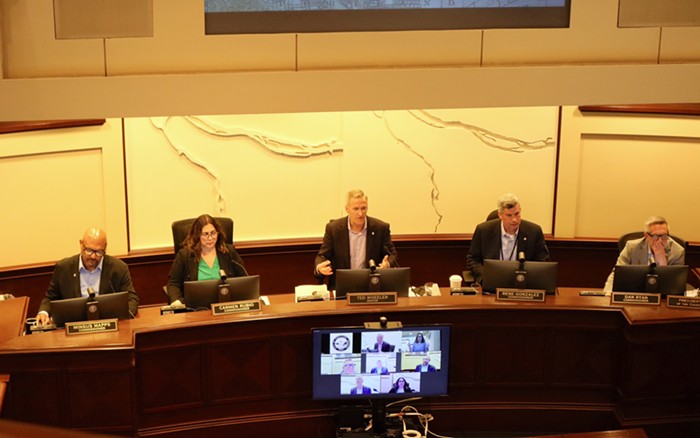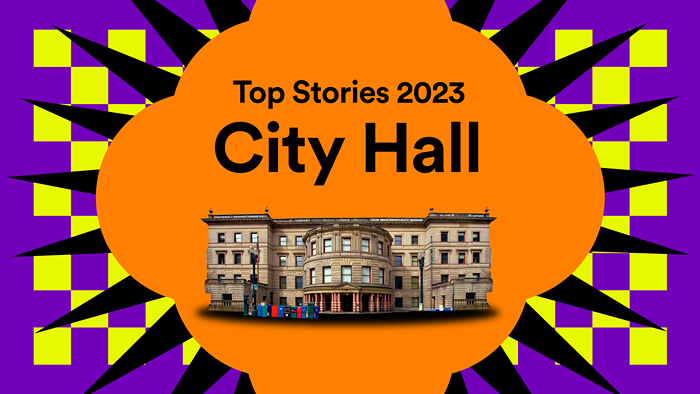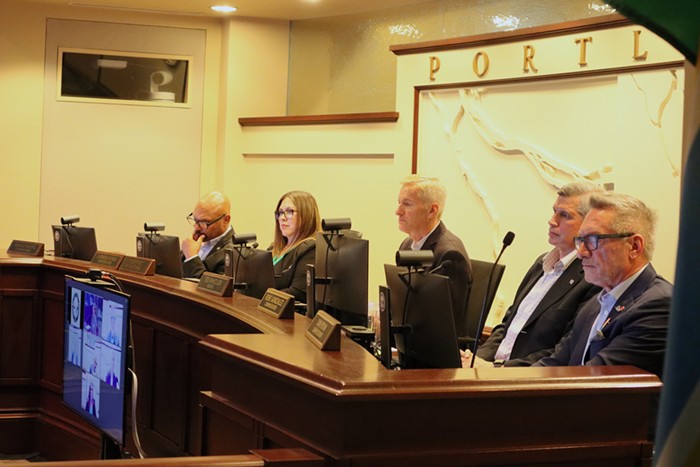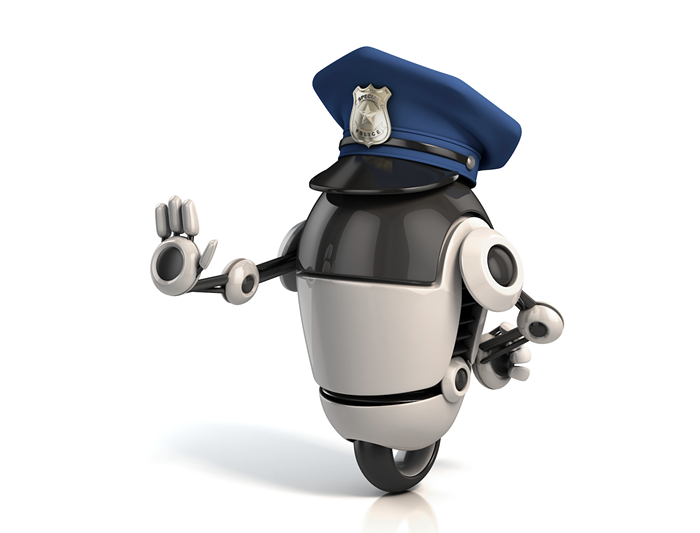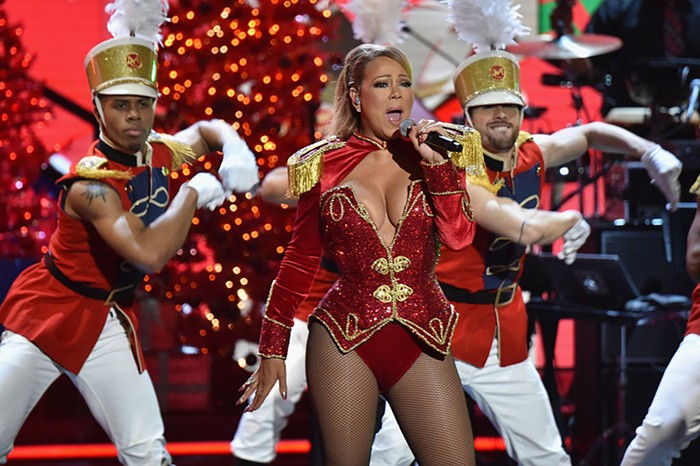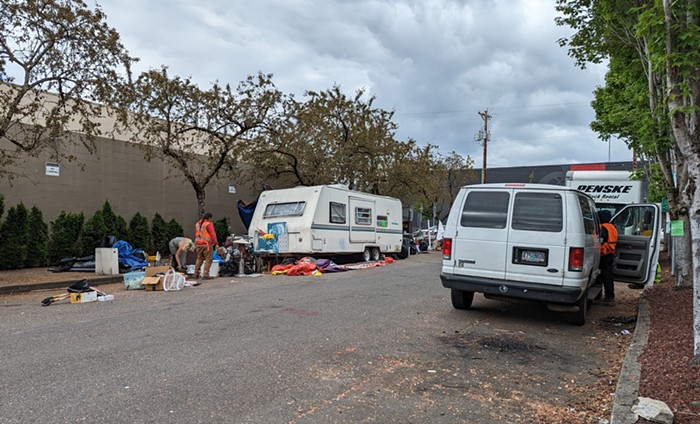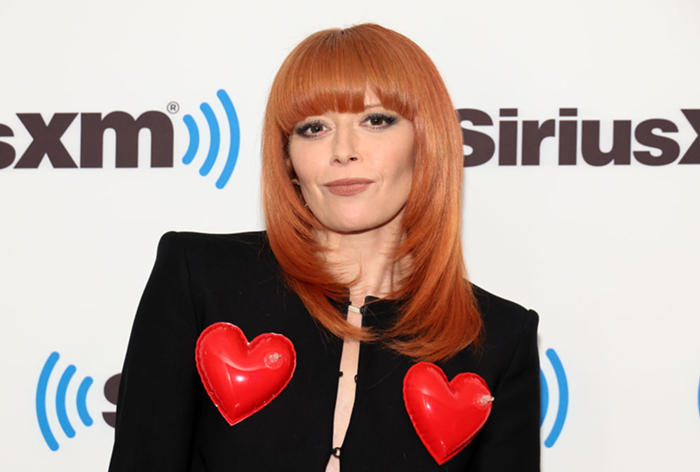A long-awaited report by the city's Independent Police Review faults hazy or non-existent protocols and incomplete record-keeping for its inability to definitively prove—or disprove—a widespread "belief in the hip-hop community" that Portland cops heap disparate scrutiny on "hip-hop shows or other events perceived to have a significant portion of black patrons."
But despite that lack of hard data—blamed matter-of-factly on a "lack of transparency"—the review is unsparingly critical in parts. It gives credence to what's become a deeply held perception in the black community, especially in light of "historically strained relationships" with the police bureau. And it strongly urges city officials, no matter officers' actual intentions, to take those concerns to heart.
Even the perception of bias in Portland "should greatly concern city officials," the review says in the midst of a list of recommendations—including calls to start a more thorough dialog with hip-hop artists and to begin collecting and sharing the kind of empirical data that might put any worries about profiling to rest.
"Such a belief, if allowed to persist," the review continues, "will continue to do lasting damage to the community's perception of its city government and will undermine the trust and openness that city leaders have publicly embraced."
The unusual policy review was launched last winter, following outcry over a heavy-handed (now infamous) police visit to a show at the (now-closed) Blue Monk. The heavily publicized show, featuring Luck-One (Hanif Collins), Illmaculate (Gregory Poe), and Mikey Vegaz (Eddie Bynum Jr.), came to an abrupt end March 1 after gang officers, concerned about Vegaz, showed up for a few minutes—leading to concerns about the Blue Monk's capacity that night, a cavalcade of cops outside (at least 14!) after a few fans didn't like being told they couldn't re-enter, and a virtual "mic drop" by Illmaculate, who stopped his set out of disgust and later vowed never to play in Portland again.
And now, months later, the report lands in the midst of a burgeoning protest movement over police accountability—sparked by the police killings of black men and boys in Missouri and Cleveland and Staten Island—that's seen young black Portlanders take the streets to raise awareness about fractured community ties in Portland, too.
One of those protest leaders, rapper Glenn Waco (Loren Ware), is featured prominently in the 26 pages (pdf) released early this morning by the IPR, alongside Illamaculate, Rasheed Jamal, and Portland legend Cool Nutz (Terrance Scott). The report takes pains to give the artists a credible voice in the ensuing discussion. It also praises their engagement and their knowledge of black history in Oregon—mixing in the artists' stories with a probing audit of the city's and state's regulatory bodies, some quick-hit history lessons, frank talk from gang officers, and a fascinating snapshot of Portland's evolving cultural landscape.
"At the heart of the debate about hip-hop's future in Portland is the looming question of whether a music form heavily indebted to African American culture can thrive or even exist in the United States' whitest major city," the report says early on, just under a section heading titled "Gentrification."
A few paragraphs beyond that line, Waco is quoted for several sentences talking about changes in Northeast Portland, neighborhoods that had been overwhelmingly African American during the second half of the 20th century, now rapidly giving way to wealthier white residents in the past decade and a half. The citation gives a sense of the wider context in play around concerns of profiling.
"It looks totally different from 15 years ago or 20 years ago whatever. And you walk through Killingsworth and you just see—well it's not there anymore. It's like totally gone. But it used to just look like decay ... This new face of what Killingsworth is about to look like, and in a sense it's like memories are fading away. A neighborhood's identity is dying, you know? In the sense of just buildings that stood there for years and year and years or houses that are kind of monuments in and of themselves is being just torn down in the place of little coffee shops and small restaurants and stuff ... That's what strains at people's hearts, you know, and that's what people see and that's on people psyches too ..."
And then a bit later, Waco returns with another gut-punch quote, after the report mentions artists' concerns that "the current view of Portland as a quirky playground for transplanted young college graduates leaves them out of the equation."
"Well it's like Portland has its motto of Keep Portland Weird. Like so what are you saying? We could have naked bike rides but hip-hop is too weird for Portland. Like c'mon bro, we're making music. Like it's a stereotype of gangster rap and they don't want gangsters hanging out here. Okay. What would you rather have Mr. Police Officer? Would you have a person performing music and selling albums or would you have them out in the street peddling crack ..."
The report concludes early on that the city's hip-hop scene, despite a resurgence led by performers like Illmaculate and others, is still "uniquely vulnerable"—in part because of those tectonic shifts in Portland's identity and its black communities but also because of how those changes interact with what it calls a "fragmented" and reactive "regulatory environment."
Changes in black neighborhoods, coupled with development that's priced out scrappier venues all over town, have narrowed the list of places interested in hosting hip-hop shows. That means acts have to scramble to book shows, settling on smaller venues prone to having capacity and fire safety woes that might draw the eye of police and other officials.
Worse, some of those clubs and bars rely on promoters to pack in fans, letting them handle security and rolling the dice that they might get away with exceeding whatever capacity limits might be set by the fire marshal. When promoters louse up by selling too many tickets or not keeping an eye on liquor sales or safety, the report says the promoters often skate by and leave the clubs to pay the consequences. That means, for some clubs, not doing business with hip-hop promoters the next time someone wants to pitch a show. And even when clubs might be willing, they institute policies like a ban on "baggy" clothing or certain colors—but maybe only enforce those policies against people of color.
The report spends much of its midsection trying to untangle and explain the complicated dance between the fire marshal, the Oregon Liquor Control Commission, the city's Office of Neighborhood Involvement, and the Portland Police Bureau—all of which, the report says, work both separately and together to try to keep concerts and bar shows safe, legit, and trouble-free.
But it never loses sight of the fact that cops, for better or worse, are often the face of that multi-tentacled machine. And because of historical tension between the black community and police, several artists and promoters told the IPR they don't think police "understand hip-hop culture or black people."
The biggest complaint? Cops, as the artists see it, who conflate skin color with gang ties, "failing to recognize the interconnectedness of Portland's small black community."
Though dispatch records and other documents aren't kept in sufficient detail to definitively say this—or not—artists and promoters remain unshakably convinced cops give more scrutiny to clubs seen as predominantly African American or friendly to hip-hop. In the absence of that data, the report nonetheless offers a telling anecdote showing that perception is hardly unrealistic.
In an interview with IPR, organizers of the PDX Pop Now! festival—professionals who consider themselves familiar with police protocols for large musical events—noticed an "abnormal" and "time-consuming" level of police contact after adding a handful of hip-hop shows to this year's lineup.
"Our staff and our performers noticed that hip-hop attracted the majority of our police visits," the organizers said, "even though it was only performed by four acts out of over 40 total performances."
Cool Nutz—in an interview well before groups like Don't Shoot Portland began joining national protests over police shootings and tension with minority communities—was prescient when describing the way that perception feels.
"You have to understand people's natural perception, especially in a hip-hop environment ... especially with all the stuff that's happening in society. When you have the Trayvon Martin stuff and you have the stuff of Kendra James and you have different things happening where young African Americans get killed by police or brutality or when you're in—if you're in Northeast Portland or you work in Northeast Portland, then you might get pulled over for how you look, then your mindset at a hip-hop show is are, are they here to be cool or are they here to mess with me."
One officer, bureau spokesman Sergeant Pete Simpson, met with IPR and addressed those concerns on the record. Simpson, the report notes, formerly served on the bureau's "entertainment detail"—a group of cops who start their night shifts out in Old Town and get to know bouncers and security workers and club owners while keeping an eye on potential problems.
Simpson said he's heard complaints that cops "don't like hip-hop or don't like hip-hop music, and so they're going to shut us down." But also insisted "there's no truth to that," even as he allowed the difficulty in dislodging the impression.
He blamed promoters and club owners involved with hip-hop for falling down on things like security and not over-stuffing venues—and joined other officers interviewed by IPR in mentioning a handful of cases, which happened to involve clubs known for African American customers, that have seen shootings.
A few pages later in the report, another former member of the detail, Sergeant Rich Steinbronn, didn't dispute what could be seen as cops reveling in the potentially intimidating message their visits to clubs might send.
"We would let the crowd see uniform patrol officers," he said. "It takes away some of that anonymity. People are watching."
But in the case of the notorious Blue Monk show, out on SE 34th and Belmont, it wasn't the entertainment detail that started what became a cascade of chaos.
It was the city's gang enforcement team, which professes "no police interest in music or particular genres of music," just guns and gun crimes—going so far as to tell IPR that it doesn't think its targets would even care to "be engaged in creative community endeavors."
And yet, for all those protestations, the unit also says it remains intently focused on what the report calls "social gatherings organized by gang-affiliated individuals." One anonymous cop was quoted as calling those events "very dangerous."
And because the gang team is also focused on gun crimes, and because the gang team believes most gun crimes in Portland are perpetrated by a relative handful of well-known African American gang members, that means the gang team—by its own admission in the report—is primarily concerned with policing African Americans.
The unit's complicated. It's proud of its work, some of which, oddly enough, involves building genuine relationships with the young men the unit targets. But it's also been called out in city reports for having some of the most racially disparate rates of traffic stops and searches.
Sometimes the gang team says it hears that a performer in town has gang ties or a "gang background," and so they'll "show up" at a performance to check things out. Sometimes, they admit, they "often prepare for issues that wind up not being issues."
"We know the difference between black people and gangsters," a sergeant insists in the report.
Again, because of the gang team's admitted focus on gun crimes and African American gangs, those visits are predominantly aimed at events that draw black Portlanders. Those cops cite shootings at places like Seeznin's and outside a party, frequented by gang affiliates, on the Portland Spirit.
But those are just a few cases. Waco, like a lot of artists, told IPR interviewers that he sees intimidation and stigma in that style of policing writ large, during all the shows when that's not the case. The times when cops are preparing for "issues that wind up not being issues."
"It's not only because they are police officers in a uniform, it's just like there's nothing going on. There's nothing Illegal going on. Nobody called them. They just show up and it's just like why are you here? And the police presence to people, like, it doesn't bring a reactive response like they're foaming at the mouth to do something to police, but it just instills fear like why are they here? They're looking for a reason to shut this down right now. Here we go again. It's just that stigma that comes with it."
Some of what happened at the Blue Monk, IPR contends, might have been avoided if the city had a clear policy in place for how club visits should play out and how cops are supposed to work together with other agencies. Same with artists and promoters.
There was confusion, after the show was stopped and for some time after, about why police showed up and what they wanted. Initially, it was seen as a capacity issue. The Blue Monk had let in several more people the 85 it was allowed, according to a fire inspector.
But fire inspectors came after cops working the entertainment detail had come into the club—roaming far from Old Town—and noticed a potential problem. Those cops had been alerted by gang cops earlier in the day that Vegaz was on the bill—and the gang cops said they were worried because Vegaz, a few months before, had been at a studio that was shot up in what looked like a gang attack. (Vegaz, for the record, felt profiled and denied gang involvement in an interview with the Oregonian—while saying that he and most young black men in North or Northeast probably all knew at least someone involved in the life.)
A few gang cops also visited the show, acting on a concern they might conceivably have shared with either the club or the promoter earlier in the day instead of during a show that had already started.
The fire inspector made a convincing case about show being over-capacity. That message was lost on concert-goers, however, who saw a move to limit access into the Blue Monk's basement as a consolation prize for cops who couldn't find a more serious reason to shut the club down.
Some of those patrons, who wondered why they couldn't see a show they'd paid for, were understandably upset. Some cursed at the officers. Which is when the cops called for backup—with dispatch records showing at least 14 cops rolling in hard, some with lights on, turning a weird inspection spat into something that made national news.
By then, Illmaculate, last on the bill, took the stage to say he was refusing to perform (later he equated the police response with a "murder scene")—and the night was beyond salvaging.
IPR asked him if 72 hours might be a more reasonable window for cops, worried about gang ties at a show, to air any concerns with promoters, club owners, and artists. Illmaculate said "yes, definitely."
"If we're never given clear reasons, you know, and the story changes every interview or whatever the case is, then we're not being given the tools we need to be able to correct it in the future, to be able to have this positive outlet, you know?"
In all, IPR issued five recommendations meant to address some of the larger challenges in knitting together Portland's larger regulatory ecosystem—but also meant to reassure black Portlanders that cops really don't, like they claim, care about "particular genres of music."
First on the list was coming up with a checklist of expectations for late-night businesses, followed by crafting a specific police policy providing guidance for cops charged doing walk-throughs of clubs. Next, however, were calls for the cops and fire inspectors to begin tracking their walk-throughs and visits, and reporting those results to the public.
In an attempt to document those concerns [about profiling], IPR searched dispatch records for police presence at hip-hop concerts held over a three month period during the summer of 2014. The overall results were inconclusive due to a concern that sometimes officers did not notify dispatch if they were at at an event and a lack of documentation of what led to police presence at events where they did appear.
One way to move the conversation beyond conflicting narratives of whether police are present at hip hop event more often that other types of music events, is for there to better documentation by PPB on the walk-throughs it does conduct. Currently members of the public do not have much access to a wider context of where, why, and how often PPB units conduct walk-throughs of bars, nightclubs, and event spaces. PPB's lack of transparency in this regard, allows individual incidents to be magnified because concerned members of the public do not have knowledge of the wider context. PPB should track the walk-throughs it conducts at venues in a format that would allow it to regularly report such information to the public.
IPR also insists cops bring artists and promoters into regular meetings with state and city regulators and bar owners.
"If everybody's on the same page," IPR Director Constantin Severe told me in an interview, "it helps a lot in lowering the temperature and preventing things from spilling out."

